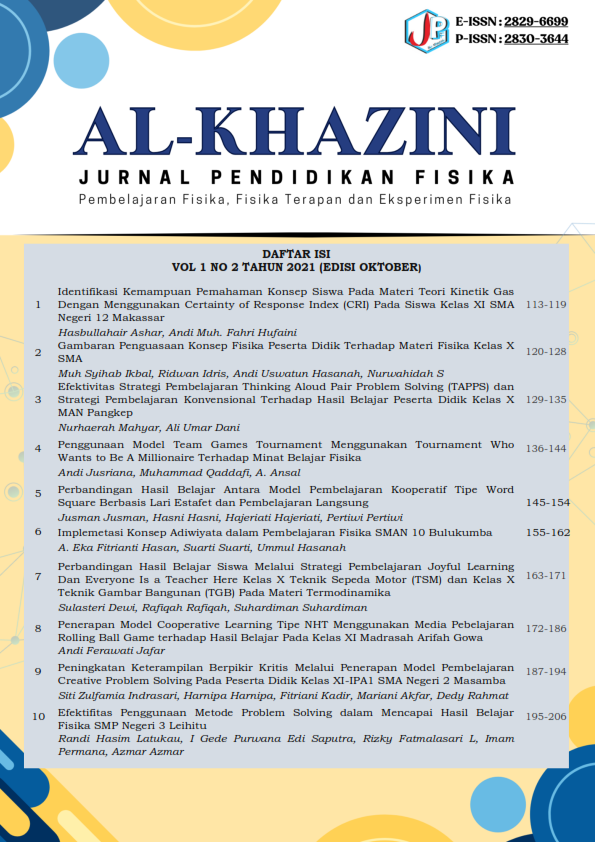Perbandingan Hasil Belajar Siswa Melalui Strategi Pembelajaran Joyful Learning Dan Everyone Is A Teacher Here Kelas X Teknik Sepeda Motor (TSM) Dan Kelas X Teknik Gambar Bangunan (TGB) Pada Materi Termodinamika
Abstract
The purpose of this study is to: compare learning outcomes between students who are taught the Joyful Learning strategy with the Every One is A Teacher Here strategy on thermodynamics class X SMKN 1 South Sulawesi. This type of research is classified as pre-experimental using a comparative study research approach, learning outcomes after being taught using the Joyful Learning learning strategy with the Every One is A Teacher Here learning strategy for students in class X TSM and class X TGB. The results showed that the class taught using the Joyful Learning learning strategy the average value of the students was in the good predicate category (B+), and the class taught using the Every One is A Teacher Here learning strategy the average student score was in the good category (B). It was concluded that there was a difference between the classes taught using the Joyful Learning learning strategy with higher learning outcomes than the classes taught using the Every One is A Teacher Here learning strategy.The implications of this research are: In learning physics to get high participation from each student, as an option, you can use the Every One Is a Teacher Here learning strategy, and to make students not feel pressured, they can use the Joyful Learning learningstrategy as an option.
Downloads
References
Anantyas Kusuma Dewi, Pujayanto, dan Elvin Yusliana Ekawati, “Eksperimen Model Blended Learning dan Joyful Learning Sub Tema EkosistemAir Tawar Ditinjau dari Aktivitas Siswa Kelas VII SMPN 9 Surakart”, Jurnal Materi dan Pembelajaran Fisika (JMPF) Volume 5 Nomor 1 (2015) https://core.ac.uk (diakses 28 April 2016).
Aqib, Zainal. Model-Model, Media, dan Strategi Pembelajaran Kontekstual. Bandung: Yrama Widya, 2013
Arends, Ricards I. Learning to Teach, Sixth Edition. New York dan San Fransisco: McGraw-Hill Companies, 2004.
Danim, Sudarwan dan Khairil. Psikologi Pendidikan dalam Perspektif Baru. Bandung: Alfabeta, 2011.
Fathurrohman, Muhammad. Model-Model Pembelajaran Inovatif. Jogjakarta: Ar-Ruzz Media, 2015.
Hamalik, Oemar. Proses Belajar Mengajar, Cet. X. Jakarta: Bumi Aksara, 2009.
Hamdayama, Jumanta. Model dan Metode Pembelajaran Kreatif dan Berkarakter. Bogor: Ghalia Indonesia, 2014.
Hermawan, Dwi, dkk. Pengaruh Pendekatan Joyful Learning Berbasis Multimedia Terhadap Hasil Belajar IPS pada Siswa Kelas V SD Gugus 8 I Gusti Ngurah Rai Denpasar Selatan. Denpasar: Jurnal Mimbar PGSD Universitas Pendidikan Ganesha, 2014.
Intan Permatasari, Aprilia, Bakti Mulyani, Nanik Dwi Nurhayati, “Efektivitas Penggunaan Model Pembelajaran Joyful Learning dengan Metode Pemberian Tugas Terhadap Prestasi Hasil Belajar Siswa pada Materi Pokok Koloid Siswa Kelas XI IPA SMA Negeri 1 Simo Tahun Pelajaran 2012/2013”, Jurnal Pendidikan Kimia Vol. 3 No1 (2014) http://www.jurnal.fkip.uns.ac.id (diakses 28 April 2016).
Jack R dan Norman E. Wallen. How to Design and Evaluate Research in Education. Edisi VII. New York: Mc Graw-Hill, 2009.
Jaedun, Amat. Metodologi Penelitian Eksperimen. Fakultas Teknik UNY: Pelatihan Penulisan Artikel Ilmiah oleh LPMP, 2011.
Juniyarti, Eka. Hubungan Partisipasi Siswa dengan Hasil Belajar Siswa di SMP Negeri 1 Suwawa. Gorontalo: Universitas Negeri Gorontalo, 2015.
Kurniawan, Deni. Pembelajaran Terpadu Tematik, Bandung: Alfabeta: 2014.
Mania, Sitti. Pengantar Evaluasi Pengajaran. Makassar: Alauddin University Press, 2012¬.
Misbahuddin & Iqbal Hasan. 2013. Analisis Data Penelitian dengan Statistik Edisi Ke 2. Jakarta: Bumi Aksara.
Ochimath, Peningkatan keaktifan belajar matematika melalui metode pembelajaran berbasis joyful learning, dalam http: //Ochimath.wordpress.com/.
Peraturan Menteri Pendidikan dan Kebudayaan Republik Indonesia Nomor 66 Tahun 2013 Tentang Standar Penilaian Pendidikan
Prasetyo, Bambang. Metodolgi Penelitian Pendidikan Kuantitatif. Jakarta: PT. Rajagrafind Persada, 2014.
Purwanto. Evaluasi Hasil Belajar. Yogyakarta: Pustaka Belajar, 2011.
Retnawati, Heri. Validitas Reliabilitas dan Karakteristik Butir. Yogyakarta: Parama Publishing: 2016.
Sagala, Syaiful. Supervisi Pembelajaran Dalam Profesi Pendidikan: Membantu Mengatasi Kesulitan Guru Memberikan Layanan Belajar yang Bermutu. Bandung: Alfabeta, 2010.
Sudjana, Nana. Dasar-dasar Proses Srategi Belajar Mengajar. Edisi X. Sinar Baru Algesindo: Bandung, 2009.
Sugiyono. Metode Penelitian Pendidikan Pendekatan Kuantitatif, Kualitatif, dan R&D. Bandung: Alfabeta, 2010.
Trianto. Mendesain Model Progresif: Konsep, Landasan dan Implementasinya pada Kurikulum Tingkat Satuan Pendidikan. Jakarta: Kencana Prenada Media, 2009.
Tukarno, “Meningkatkan Penguasaan Teknik Gradasi Warna Melalui Pendekatan Joyful Learning pada Program studiKria Kulit Kelas X”, Jurnal Inspirasi Pendidikan Universitas Kanjuruhan Malang (2012) http://ejournal.unikama.ac.id/index.php/jrnspirasi (diakses 28 April 2016).
The Authors submitting a manuscript do so on the understanding that if accepted Al-Khazini:Jurnal Pendidikan Fisika for publication, copyright publishing of the article shall be assigned/transferred to Physics Education Department, UIN Alauddin Makassar as Publisher of the journal. Upon acceptance of an article, authors will be asked to complete a 'Copyright Transfer Agreement'. An e-mail will be sent to the corresponding author confirming receipt of the manuscript together with a 'Copyright Transfer Agreement' form by the online version of this agreement.
Al-Khazini:Jurnal Pendidikan Fisika and Physics Education Department, UIN Alauddin Makassar, , and Physics Society of Indonesia as the Editors and the Advisory International Editorial Board make every effort to ensure that no wrong or misleading data, opinions or statements be published in the journal. In any way, the contents of the articles and advertisements published in the Al-Khazini:Jurnal Pendidikan Fisika are the sole and exclusive responsibility of their respective authors and advertisers.
The copyright form should be signed electronically and send to the Editorial Office in the form of the original e-mail: [email protected]

